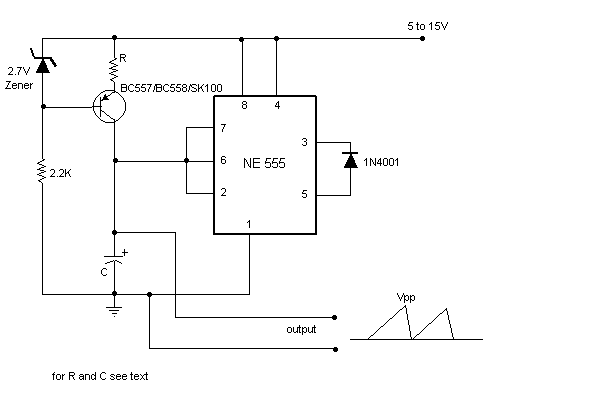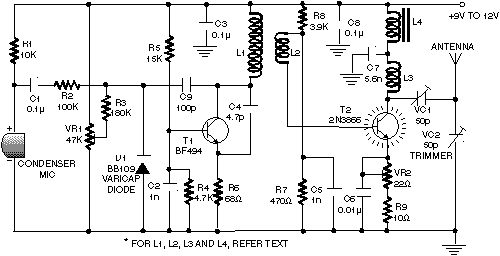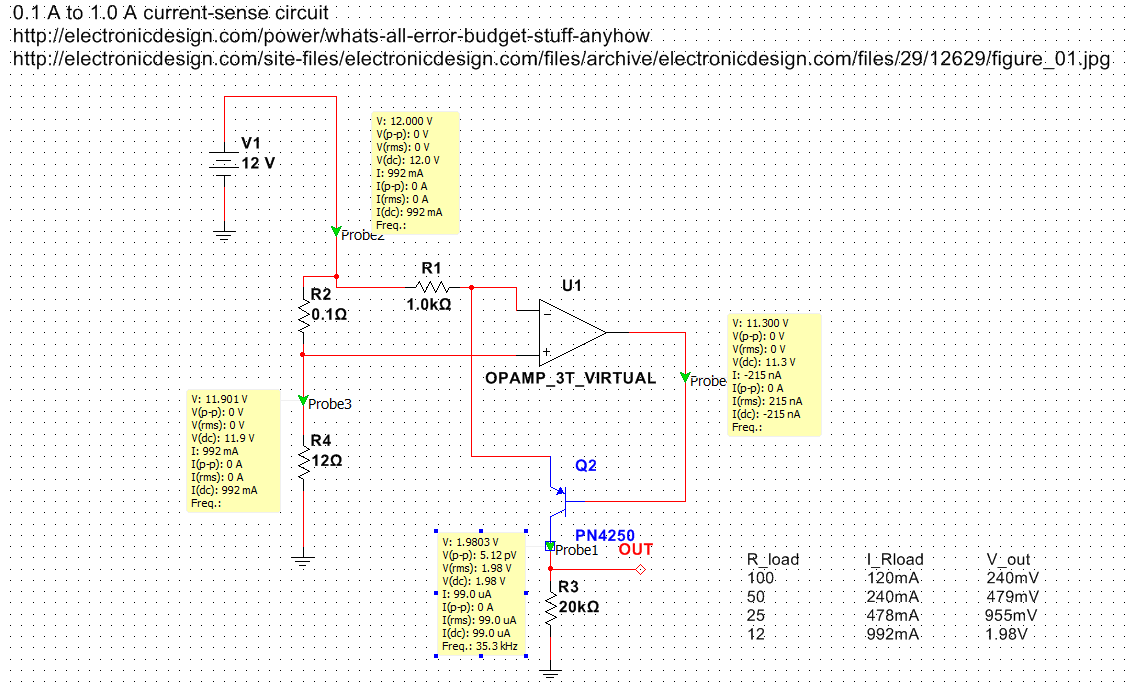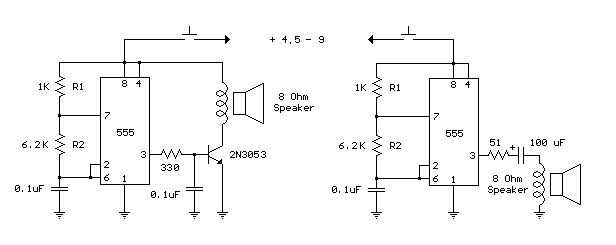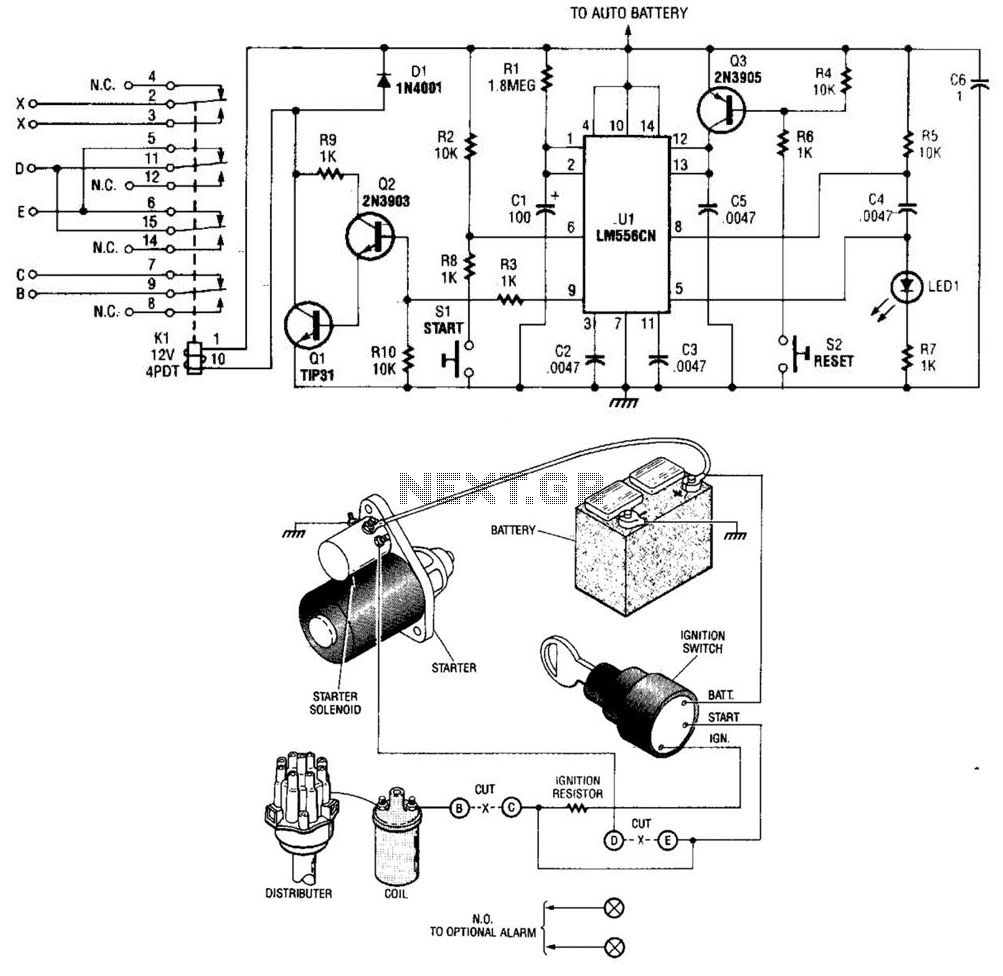
Whistle Responder Schematic circuit
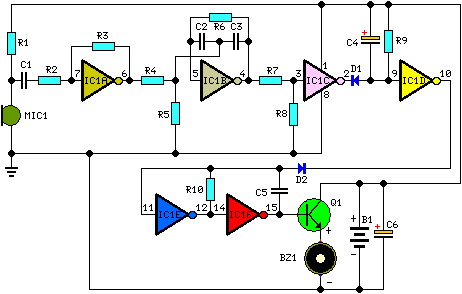
This device emits intermittent beeping for approximately two seconds when a whistle is detected within a range of several meters. The first two inverters in IC1 function as audio amplifiers. IC1A consistently amplifies the signal captured by a small electret microphone, while IC1B serves as a band-pass filter, centered at around 1.8 kHz. This filter is essential for isolating the specific frequency of the whistle and preventing other frequencies from triggering the beeper unintentionally. IC1C is configured as a Schmitt trigger, which converts the incoming audio signal into a square wave. IC1D operates as a monostable multivibrator with a two-second delay, controlling the astable multivibrator formed by IC1E and IC1F. This oscillator produces a square wave at a frequency of 3 to 5 Hz, which drives transistor Q1 and buzzer BZ1, resulting in the intermittent beeping sound.
The circuit design employs an electret microphone that converts sound waves into an electrical signal. The output from the microphone is fed into the first inverter (IC1A), which amplifies the signal to a usable level. The amplified signal is then routed to the second inverter (IC1B), where it passes through a band-pass filter. This filter is crucial as it allows only the desired frequency range (approximately 1.8 kHz) to pass while attenuating other frequencies, thereby reducing false triggering caused by background noise.
The output from the band-pass filter is then processed by the Schmitt trigger (IC1C). The Schmitt trigger is designed to provide a clean digital signal by converting the analog audio signal into a square wave, which is more suitable for digital processing. This square wave is then fed into a monostable multivibrator (IC1D), which generates a pulse of a fixed duration (two seconds) in response to the detected whistle.
Following the monostable multivibrator, the circuit transitions to an astable multivibrator configuration formed by IC1E and IC1F. This configuration generates a continuous square wave output at a frequency between 3 to 5 Hz, which is used to drive the transistor (Q1). The transistor acts as a switch, controlling the current flow to the buzzer (BZ1). When the transistor is activated, the buzzer produces an intermittent sound, effectively alerting the user to the detected whistle.
In summary, this circuit effectively combines audio amplification, frequency filtering, signal conditioning, and timing functions to create a responsive and reliable whistle detection system that provides audible feedback through an intermittent beeping sound.This device beeps intermittently for about two seconds when a person in a range of around meters emits a whistle. The first two inverters contained in IC1 are used as audio amplifiers. IC1A amplifies consistently the signal picked-up by the small electret-microphone and IC1B acts as a band-pass filter, its frequency being centered at about 1.8KHz.
The filter is required in order to select a specific frequency, the whistle`s one, stopping other frequencies that would cause undesired beeper operation. IC1C is wired as a Schmitt trigger, squaring the incoming audio signal. IC1D is a 2 second-delay monostable driving the astable formed by IC1E & IC1F. This oscillator generates a 3 to 5Hz square wave feeding Q1 and BZ1, thus providing intermittent beeper operation..
🔗 External reference
The circuit design employs an electret microphone that converts sound waves into an electrical signal. The output from the microphone is fed into the first inverter (IC1A), which amplifies the signal to a usable level. The amplified signal is then routed to the second inverter (IC1B), where it passes through a band-pass filter. This filter is crucial as it allows only the desired frequency range (approximately 1.8 kHz) to pass while attenuating other frequencies, thereby reducing false triggering caused by background noise.
The output from the band-pass filter is then processed by the Schmitt trigger (IC1C). The Schmitt trigger is designed to provide a clean digital signal by converting the analog audio signal into a square wave, which is more suitable for digital processing. This square wave is then fed into a monostable multivibrator (IC1D), which generates a pulse of a fixed duration (two seconds) in response to the detected whistle.
Following the monostable multivibrator, the circuit transitions to an astable multivibrator configuration formed by IC1E and IC1F. This configuration generates a continuous square wave output at a frequency between 3 to 5 Hz, which is used to drive the transistor (Q1). The transistor acts as a switch, controlling the current flow to the buzzer (BZ1). When the transistor is activated, the buzzer produces an intermittent sound, effectively alerting the user to the detected whistle.
In summary, this circuit effectively combines audio amplification, frequency filtering, signal conditioning, and timing functions to create a responsive and reliable whistle detection system that provides audible feedback through an intermittent beeping sound.This device beeps intermittently for about two seconds when a person in a range of around meters emits a whistle. The first two inverters contained in IC1 are used as audio amplifiers. IC1A amplifies consistently the signal picked-up by the small electret-microphone and IC1B acts as a band-pass filter, its frequency being centered at about 1.8KHz.
The filter is required in order to select a specific frequency, the whistle`s one, stopping other frequencies that would cause undesired beeper operation. IC1C is wired as a Schmitt trigger, squaring the incoming audio signal. IC1D is a 2 second-delay monostable driving the astable formed by IC1E & IC1F. This oscillator generates a 3 to 5Hz square wave feeding Q1 and BZ1, thus providing intermittent beeper operation..
🔗 External reference
Warning: include(partials/cookie-banner.php): Failed to open stream: Permission denied in /var/www/html/nextgr/view-circuit.php on line 713
Warning: include(): Failed opening 'partials/cookie-banner.php' for inclusion (include_path='.:/usr/share/php') in /var/www/html/nextgr/view-circuit.php on line 713
